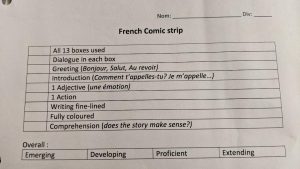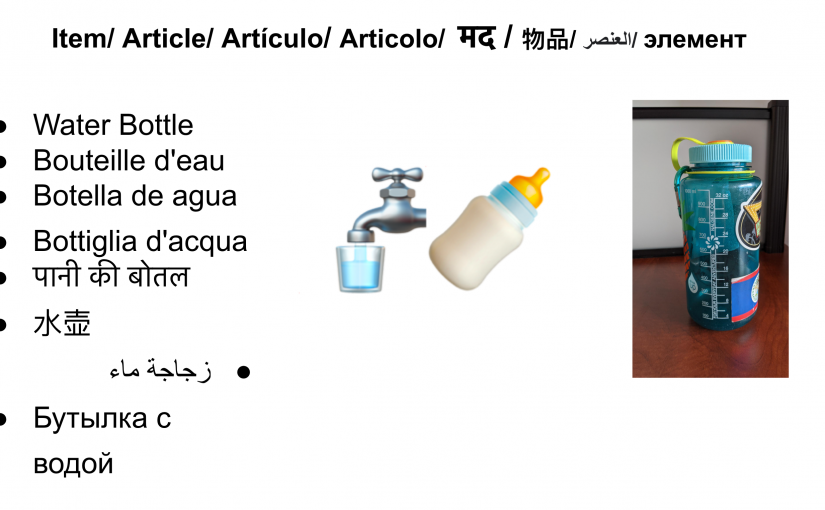Here’s what I came up with for this weeks Task Redesign: ETEC540 – Can You Hear What’s In My Bag?
For me, this task was most definitely the most difficult encountered in ETEC540 thus far. It wasn’t because of the challenge of bending the mode of expression and meaning (although that did pose an interesting provocation), rather it was wrapping my head around the theories informing this practice. It seems to me that the underlying conditions of multiliteracies are heavily (but not entirely) dependent upon postmodern style thinking; I am still not entirely convinced of its principles.
My qualms do not reside in the expression of multimodalities (ie – visual, auditory, linguistic, tactile, gestural etc). I think these are fairly straightforward and reasonable. I believe we are able to form a more holistic interpretation as we incorporate more and more modes of meaning. It’s more about the interpretation that the meanings created by these modalities are unbound to any type of hierarchy of reasonable comprehension. Cope and Kalantzis assert:
“What the meaning maker creates is a new design, an expression of their voice which draws upon the unique mix of meaning-making resources, the codes and conventions they happen to have found in their contexts and cultures. The moment of design is a moment of transformation, of remaking the world by representing the world afresh” (Cope & Kalantzis, 2009).
This is all well and good, and I do believe that, in my case for example, I have drawn upon a multitude of meaning-making resources, the conventions available to me, and have transformed an old representation into new. But to draw upon the postmodern position, and say that my interpretation is one of infinite and therefore is relevant only on a subjective level is somewhat foolish. Despite the fact there may be infinite means of interpretation, there remains only a finite number of reasonable interpretations. I cannot conjure up any idea of what societies would look like if there were no objective truths embedded within human meaning making.
Cope and Kalantzis use an example of a student who is unable to ‘get’ the culture of writing due to that student’s cultural, ethnic, or social makeup and that multiliteracies can be used as a type of entry point to literacy. This is absolutely the case, however, educators often understand this as a strategy of elimination: that the student’s subjectivity trumps the requirement to improve his/her writing or meet some type of success criteria, catering to that student’s other multi-modal strengths, without addressing or building upon the weakness. This is absolutely not to say that the students’ subjective output isn’t significant or important, however, culture dictates the social hierarchies of competency, and educators are doing their students a disservice by skirting the requirements and not equipping them with the basic tools necessary to climb and participate in it.
Consequently, how does multimodalities and it’s postmodern foundation stand up to pedagogical assessment/ self-assessment practices? I struggle with comprehending how it’s possible to assess a subjectively constructed artifact with an objective criteria. How is it possible to agree upon a common success criteria if every participant’s success criteria is interpreted differently? There must be a reasonable and commonly agreed upon interpretation. For example, the following image is an success criteria from my partner who teachers elementary French:

Let’s take Comprehension (Does the story make sense) – If we are going to embrace a pedagogy that dictates subjective meaning is ‘representing the world afresh’ and that everyone’s unique perspective and interpretation is ‘acceptable’ then on what grounds does an educator have to assess the comprehension level of a student? This submitted representation needs only to be fully comprehended by them and them only. Overall, I take no issue with the surface level notion of multi-modalities and the importance of incorporating it into pedagogy, however, I am wary to fully embrace its underlying theories particularly due to its proximity to postmodernism.
With respect to my own project:
Evoking the New London Group, I have appealed to hybridity and intertextuality in my mode-bending project – I’ve drawn attention to the complex ways in which meaning can be constituted through the relationship between various modes and have articulated novel practices and conventions between modes of meaning (New London Group, 1996). In this case, I’ve chained together a number of modalities to permit the viewer/reader to construct an interpretative meaning. For example, the linguistic representations of a water bottle differs exponentially once we depart from the Latin based languages, yet the sound reflective of the water bottle stays stagnant and unchanged across cultures. The visual interplay between the photo of the physical water bottle and an emoji-style reconstruction also challenges the reader/viewer to negotiate some semblance of a reasonable interpretation between the two.
As an English teacher, these ideas prompt me to think about the futures of narrative reading and writing: Will the classic characterization of the ‘book’ one day transform into a multi-modal form whereby the relating of a story will utilize auditory, linguistic, spatial, or gestural features? To what extent does this already exist in, let’s say, virtual reality?
Cope, B. & Kalantzis, M. (2009). Multiliteracies: New literacies, new learning. Pedagogies: An International Journal, 4:3, 164-195, DOI:10.1080/15544800903076044
The New London Group. (1996). A pedagogy of multiliteracies: Designing social futures. Harvard Educational Review 66(1), 60-92.
